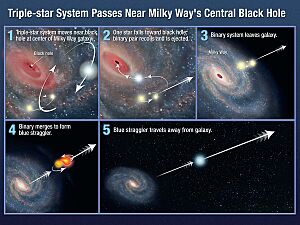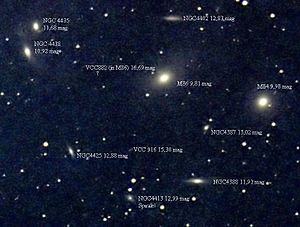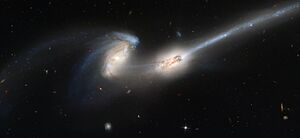Intergalactic star facts for kids
Imagine a star floating all alone in the vast darkness of space, far away from any galaxy. These special stars are called intergalactic stars. You might also hear them called intracluster stars or rogue stars. Unlike most stars, they are not held by the gravity of a galaxy.
Scientists believe these stars once belonged to galaxies, just like our Sun belongs to the Milky Way. But something big happened! They were likely kicked out when galaxies crashed into each other. Or, sometimes, a star system got too close to a giant supermassive black hole at the center of a galaxy. These powerful events can send stars flying into the empty space between galaxies.
In scientific talks, these stars are often grouped together and called the "intracluster stellar population," or "IC population" for short.
Contents
Discovering Stars on Their Own
For a long time, people thought all stars lived inside galaxies. But in January 1997, scientists made an amazing discovery! They found stars floating freely in space, outside of any galaxy. These were the first intergalactic stars ever found.
They were first spotted in a huge group of galaxies called the Virgo Cluster. Scientists now think there might be as many as one trillion (that's a 1 followed by 12 zeros!) of these lonely stars in that cluster alone.
How Do Stars Become "Rogue"?
How do stars end up all alone in the vastness between galaxies? Scientists have a few ideas, and they are still studying this mystery!
Galactic Collisions
One main idea is that when two or more galaxies crash into each other, some stars get thrown out. Imagine two huge cities colliding! The gravitational forces during these crashes can be so strong that they fling stars far away. It's like a cosmic slingshot!
Scientists think many of these "rogue" stars might come from very small galaxies. It's easier for stars to escape the weaker gravity of a small galaxy. But even when giant galaxies collide, the powerful disturbances can also kick stars out. For example, studies of exploding stars (called supernovae) in intergalactic space suggest they came from stars that were ejected during galactic collisions. This happens when the giant black holes at the centers of two colliding galaxies merge.
Black Hole Slingshots
Another idea, which can happen alongside galaxy collisions, involves supermassive black holes. Many galaxies have a supermassive black hole at their very center. If a star, or a group of stars, gets too close to one of these giant black holes, something incredible can happen.

Imagine a star system with several stars. If they get too close to the black hole, some stars might get pulled in. But others could be flung away at incredibly high speeds! This "slingshot" effect can make a star move so fast that it escapes the gravity of its entire galaxy. These super-fast stars are sometimes called hypervelocity stars. Scientists have even calculated that our own Milky Way's central black hole might kick out one star every 100,000 years!
How We Study These Stars
Scientists use powerful telescopes and clever techniques to find and study these distant, lonely stars.
In January 1997, the Hubble Space Telescope helped discover many intergalactic stars in the Virgo Cluster. Later that same month, another study confirmed that astronomers had actually found a group of intergalactic planetary nebulae (which are glowing gas clouds around dying stars) in the Fornax Cluster back in 1992 and 1993.
In 2005, a team led by Warren Brown at the Smithsonian Center for Astrophysics tried to measure how fast these hypervelocity stars were moving. They used a method called the Doppler Technique. This is similar to how the sound of a siren changes as an ambulance moves towards or away from you. By looking at how the light from a star changes, they can estimate its speed. They found some stars moving incredibly fast, over a million miles per hour!
Later, in the late 2000s, scientists noticed a faint glow in the space between galaxies. At first, they didn't know what caused it. But in 2012, it was suggested that this glow might come from all the intergalactic stars! Further studies have helped us understand this "diffuse extragalactic background radiation" in more detail.
More recently, astronomers from Vanderbilt University reported finding over 675 stars at the very edge of our Milky Way galaxy, between us and the Andromeda Galaxy. They believe these are hypervelocity stars that were shot out from the Milky Way's center. These stars are "red giants" and have a high "metallicity" (meaning they have more heavy elements than usual). This suggests they came from the inner parts of a galaxy, not from the older, outer regions.
Scientists have also found exploding stars (supernovae) hundreds of thousands of light-years away from any galaxy. This is strong evidence of intergalactic stars. However, many of the intergalactic stars found near our Milky Way seem to have come from the main disk of our galaxy, not just its very center.
The Total Weight of Rogue Stars
In 2005, the Spitzer Space Telescope found a new kind of infrared light coming from the background of the universe. Since then, other telescopes have found similar patterns in blue light and X-rays. Scientists now call this the "diffuse extragalactic background radiation."
In 2012, a new idea was proposed: what if this faint background glow comes from all the intergalactic stars? If this is true, it means these lonely stars might collectively weigh as much as all the stars inside galaxies! This huge amount of mass could help explain some big mysteries in space, like why there seems to be less light than expected in some areas, and it might even help us understand the puzzle of dark matter.
Where Can We Find Them?
The first intergalactic stars were discovered in the Virgo Cluster of galaxies. These stars are truly isolated, living about 300,000 light-years away from the closest galaxy. Even though it's hard to measure their exact weight, scientists believe that intergalactic stars make up about 10 percent of the total mass of the Virgo Cluster. This means they might even weigh more than any single one of the 2,500 galaxies in that cluster!
In 2012, astronomers found about 675 rogue stars at the edge of our own Milky Way galaxy, heading towards the Andromeda Galaxy. These stars were likely kicked out from the Milky Way's center after interacting with its giant supermassive black hole. A study led by Kelly Holley-Bockelmann and Lauren Palladino from Vanderbilt University pointed out that these stars were unusually red and moving very fast. This showed their incredible journey from the galactic center.
See also
- Blue straggler
- HE 0437-5439
- Intergalactic dust
- Intracluster medium
- Rogue planet, or interstellar planet
- Rogue black hole
- Stellar kinematics



